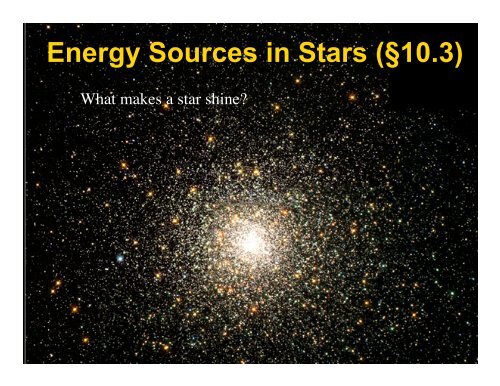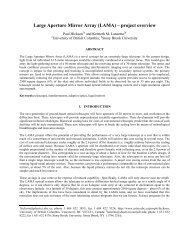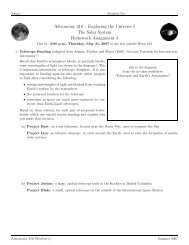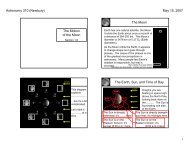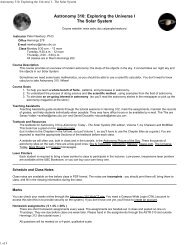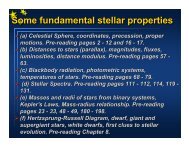Energy Sources in Stars (§10.3)
Energy Sources in Stars (§10.3)
Energy Sources in Stars (§10.3)
Create successful ePaper yourself
Turn your PDF publications into a flip-book with our unique Google optimized e-Paper software.
<strong>Energy</strong> <strong>Sources</strong> <strong>in</strong> <strong>Stars</strong> (§10.3)What makes a star sh<strong>in</strong>e?
<strong>Energy</strong> <strong>Sources</strong> <strong>in</strong> <strong>Stars</strong> (§10.3)What makes a star sh<strong>in</strong>e?Sun’s s <strong>Energy</strong> OutputL sun = 4 x 10 26 W (J s -1 )sun 4.5 x 10 9 yr (1.4 x 10 17 s) - oldest rocks - radioactive dat<strong>in</strong>gt sunL sun ~ constant over geological timescale (fossil evidence)Therefore total energy output E tot = L sun x t sun = 6 x 10 43How might the Sun have generated this energy?43 J
<strong>Energy</strong> <strong>Sources</strong> <strong>in</strong> <strong>Stars</strong><strong>Energy</strong> Source #3:Nuclear <strong>Energy</strong>Fission?Z = 0.02 (2% Sun consists of heavy elements).Fissionable isotopes like 235 U are rare (isotopes are nucleiiwith the same # protons but different # neutrons)Fusion?e.g. 4 protons get converted <strong>in</strong>to 2p + 2n i.e. i4H → 1 4 HeH is very abundant <strong>in</strong> the Sun (X = 0.73)4 H nuclei: mass = 4 x m p = 6.693 x 10 -27 kg1 4 He nucleus: mass = 6.645 x 10 -27 kg (b<strong>in</strong>d<strong>in</strong>g energy <strong>in</strong>cluded)Difference is 0.048 x 10 -27 kg = 0.7% of orig<strong>in</strong>al massWhere does this mass go?
<strong>Energy</strong> <strong>Sources</strong> <strong>in</strong> <strong>Stars</strong><strong>Energy</strong> Source #3:Nuclear <strong>Energy</strong>The “lost” mass is converted <strong>in</strong>to energy accord<strong>in</strong>g to E<strong>in</strong>ste<strong>in</strong>’sequation for the rest energy of matter: E = mc 2 (E energy, mmass, c speed light)Example:Suppose that Sun was orig<strong>in</strong>ally 100% H and only 10% of that wasavailable for fusion. Thus…M H available = 0.1 M sunΔM H destroyed through fusion = 0.1 M sun x 0.007total nuclear energy available E tot = (7 x 10 -4 M sun )c 2 ~ 1.3 x 10 44Sun’s s total lifetime energy output = 6 x 10 43 JE tot ~ 2 x the total energy Sun has emitted!!→ Sun could sh<strong>in</strong>e for at least another 5 x 10 9 yr at its current lum<strong>in</strong>osityHence t nuclear for Sun ~ 10 10 yrs44 J
<strong>Energy</strong> <strong>Sources</strong> <strong>in</strong> <strong>Stars</strong><strong>Energy</strong> Source #3:Nuclear <strong>Energy</strong>Fission?Z = 0.02 (2% Sun consists of heavy elements).Fissionable isotopes like 235 U are rare (isotopes are nucleiiwith the same # protons but different # neutrons)Fusion?e.g. 4 protons get converted <strong>in</strong>to 2p + 2n i.e. i4H → 1 4 HeH is very abundant <strong>in</strong> the Sun (X = 0.73)4 H nuclei: mass = 4 x m p = 6.693 x 10 -27 kg1 4 He nucleus: mass = 6.645 x 10 -27 kg (b<strong>in</strong>d<strong>in</strong>g energy <strong>in</strong>cluded)Difference is 0.048 x 10 -27 kg = 0.7% of orig<strong>in</strong>al massWhere does this mass go?
Can Fusion Occur <strong>in</strong> Sun’s s Core?Protons must overcome mutual electrostatic repulsion: CoulombBarrierClassical Approach: E k<strong>in</strong> proton > E coulomb 1/2 m p v 2 > e 2 /r (cgs(form) LHS is thermal gas energy,thus, 3/2 kT >e 2 /r At T central ~ 1.6 x 10 7 K → E k<strong>in</strong>~ 3.3 x 10 -16 J For successful fusion, r ~10 -15 m (1 fm) →E coulomb ~ 2.3 x 10 -13 J E k<strong>in</strong> ~ 10 -3 E coulombClassically, would need T~10 10 to overcome Coulomb barrierSo, no Fusion??
Can Fusion Occur <strong>in</strong> Sun’s s Core?Can we be helped by consider<strong>in</strong>g the distribution of energies? - notall protons will have just E th = 3/2 kTProton velocities are distributed accord<strong>in</strong>g to the Maxwellianequation: P(v) = 4π(m/24(m/2πkT)3/2 v 2 e -mv2 /2kTAt the high energy tail of the Maxwellian distribution, the relativenumber of protons, with E > 10 3 x E th is:N(E coulomb ~ 10 3 )/N() ~ e -ΔE/kt~ e -1000 = 10 -430 !!Number protons <strong>in</strong> Sun = M sun /M H ~ 10 57 so 1 <strong>in</strong> 10 430 of thesewill have enough energy to overcome Coulomb barrier.So aga<strong>in</strong>, no nuclear reactions??
Can Fusion Occur <strong>in</strong> Sun’s s Core?Even with tunnell<strong>in</strong>g, , are stars hot enough for nuclear reactions to proceed?λ = h/p is the wavelength associated with a massive particle (p = momentum)In terms momentum, the k<strong>in</strong>etic energy of a proton is:1/2 m p v 2 = p 2 /2m pAssum<strong>in</strong>g proton must be with<strong>in</strong> 1 de Broglie λ of its target to tunnelset distance, r, of closest approach to λ, (where barrier height = orig<strong>in</strong>al K.E.<strong>in</strong>com<strong>in</strong>g particle) gives:e 2 /r = e 2 /λ = p 2 /2m p = (h/λ) 2 /2m pSolv<strong>in</strong>g for λ (=h 2 /2m p e 2 ) and substitut<strong>in</strong>g r = λ <strong>in</strong>to 3/2 kT = e 2 /r, we get theQM estimate of the temperature required for a nuclear reaction to occur:QM = 4/3(e 4 m p /kh 2 ) - putt<strong>in</strong>g <strong>in</strong> numbersT QMT QMQM = 10 7 K which is comparable to T core . Therefore, fusion is feasible atcentre of Sun
Proton-Proton Cha<strong>in</strong>Basic particles <strong>in</strong>volved <strong>in</strong> nuclear reactionsParticlephotonneutr<strong>in</strong>oanti-neutr<strong>in</strong>oelectronpositronproton ( 1 1H)neutronSymbolγνν-e-e+p+nRest mass(kg)0>0>09 x 10 -319 x 10 -311.6 x 10 -271.6 x 10 -27Charge (e-)000-1+1+10Sp<strong>in</strong>11/21/21/21/21/21/2deuteron21H3.2 x 10 -27+1Conservation Laws <strong>in</strong> nuclear reactions:(1) mass-energy(2) charge(3) difference between number particles and anti-particles conserved -ie particle cannot be created from anti-particle or vice-versa but a pair can beformed or destroyed without violat<strong>in</strong>g this rule
Proton-Proton Cha<strong>in</strong>Types of nuclear reactionsBeta Decay: n → p + + e - + ν - proceeds spontaneously - also forneutron <strong>in</strong>side nucleuseg [Z-1, A] → [Z, A] + e - + ν - (Z = # p + , N = # n, A = Z+N)Inverse Beta Decay: p + + e - → n + νeg [ 13 N → 13 C + e + + ν](p + , γ) ) process: A Z + p + → A+1 (Z+1) + γeg [ 12 C + p + → 13 N + γ](α, γ) process: α particle ( 4 He) added to nucleus to make heavierparticle [ A Z + 4 He → A+4 (Z+2) + γ]eg. [ 8 Be + 4 He → 12 C + γ]
Proton-Proton Cha<strong>in</strong>S<strong>in</strong>ce the Sun’s s mass consists mostly of H and He, we anticipatenuclear reactions <strong>in</strong>volv<strong>in</strong>g these two elementsegp + + p + → 2 Hep + + 4 He → 5 Li4 He + 4 He → 8 BeBut there is a problem here - what is it?All these reactions produce unstable particlesegp + + p + → 2 He → p + + p +p + + 4 He → 5 Li → p + + 4 He4 He + 4 He → 8 Be → 4 He + 4 HeSo among light elements there are no two-particle exothermicreactions produc<strong>in</strong>g stable particles. We have to look tomore peculiar reactions or those <strong>in</strong>volv<strong>in</strong>g rarer particles
Proton-Proton Cha<strong>in</strong>Summary of proton-proton cha<strong>in</strong>:• 6p + → 4 He + 2p + + 2e + + 2ν 2 + 2γ 2 or 4p + → 4 He + 2e+ + 2ν 2 + 2γ2• Mass difference between 4p + and 1 4 He = 26.7 Mev x 6.424 x 10 18 ev/J= 4.2 x 10 -12 J• ~3% of this energy (0.8 Mev) ) is carried off by neutr<strong>in</strong>os and does notcontribute to the Sun’s s lum<strong>in</strong>osity• 2 e + immediately annihilate with 2 e - and add 2 x 0.511 Mev (= 1.02Mev)• So, the total energy available for the Sun’s s lum<strong>in</strong>osity per 4 He formedis: (26.7 - 0.8 +1.02) Mev = 26.9 Mev = 4.2 x 10 -12 J• # 4 He formed/sec = L sun /4.2 x 10 -12 J = 3.9 x10 26 J/s / 4.2x10 -12 J= 9.3 x 10 37 4 He/s• Increase of 4 He mass/time = dm He /dt = 9.3 x 10 37 4 He/s x 6.68 x 10 -27kg/ 4 He = 6.2 x 10 11 kg 4 He /sAfter 10 10 years (3 x 10 17 sec), M( 4 He) = 1.9 x 10 29 kg = 10% massSun
Proton-Proton Cha<strong>in</strong>The previous nuclearreaction cha<strong>in</strong> (PPI) is notthe only way to convert H<strong>in</strong>to He.A second branch (PPII)In solar centre, 69% of 2 3 He comb<strong>in</strong>es withanother 2 3 He, but 31% can fuse with 2 4 He32He + 4 2He " 7 4Be + #eg last step:3 He + 3 He → 4 !He + 2p +can proceed differently ifthere is appreciable 4 Hepresent!!!!!7 4Be + e " # 7 3Li + $ e73Li + p + " 4 2He + 4 2HeA third branch (PPIII)In the Sun's core, a 4 7 Be nucleus can capturea p + <strong>in</strong>stead of an e " about 0.3% of the time.4Very unstable7 Be + p + " 5 8 B + #85B " 8 4Be + e + + # e8 Be " 4 2He + 4 2He4PPI + PPII + PPIII operatesimultaneously!!
Proton-Proton Cha<strong>in</strong>: Summaryp + + p + " 1 2 H + e + + # e21H + p + " 3 2He + $69% 31%32He + 3 2He " 4 2He + 2p + 3 2He + 4 2He " 7 4Be + #!(PPI) 99.7% 0.3%!!7 4Be + e " # 7 3Li + $ e!7 Li + p + # 2 4 2He3Fraction of He 4 produced(PPII)1.00.50PPI!PPII7 4Be + p + " 8 5B + #85B " 8 4Be + e + + $ e84Be " 2 4 2He(PPIII)PPIII0 10 20 30 40T (10 6 )K)
Alternate Fusion Reactions H → 4 HeCNO Cycle (or bi-cycle)• First step <strong>in</strong> PP cha<strong>in</strong> has very lowreaction rate (weak <strong>in</strong>teraction).• 12 C can act as a catalyst <strong>in</strong> fusionreaction.• Net result:12 C + 4p + → 12 C + 4 He + 2e + + 2ν2+ 3γ3• Note: 12 C neither created nordestroyed. Also isotopes of N & Oare temporarily produced.• CNO cycle dom<strong>in</strong>ates over PPcha<strong>in</strong> if T core > 1.8 x 10 7 (slightlyhotter than Sun)THE CNO BI-CYCLE(T < 10 8 K)10 6 yr}14 m<strong>in</strong>3 x 10 5 yr3 x 10 8 yr82 s10 4 yrX as frequentlyOnce forevery 2500<strong>in</strong>stances ofCycle 1
Other Fusion ReactionsAt higher T centre , heavier nuclei can fuse to produce energyFusion of<strong>in</strong>toat T centralRef.4Hetriple α processBe, C~10 8 Kp. 31212 CO, Ne, Na, Mg6 x 10 8 Kp. 31316 OMg, Si, , S, etc.~10 9 Kp. 313We believe Universe began with only H, He, (Li, Be)All other elements created <strong>in</strong> core of stars (stellar nucleosynthesis)We are all made of “STARSTUFF”


